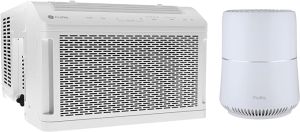Ducted air conditioners. General information

If you need to create optimal conditions in several rooms at once and prefer an air conditioner that is not visible, feel free to consider ducted air conditioning systems. You will join the ranks of wise consumers who value both attractive technical features and price points. Let's take a closer look at what makes them so popular:
The main purpose
The device and its operation
Advantages
Disadvantages
The primary purpose of a ducted air conditioner is to operate in a recirculation mode and cannot always provide fresh air to a room. This is because the temperature of air delivered to the living area should not drop below 14-16°C. Therefore, when outdoor temperatures are lower, it's necessary to warm the air taken from outside, even when operating in cooling mode.The use of air conditioners with heat pumps allows for fresh air heating during the cool season. However, during the cold season when the outdoor temperature falls below 10-15 degrees Celsius, the heating capacity of the air conditioner becomes insufficient.
To ensure year-round fresh air supply, it is necessary to install additional electric or water heaters. These heaters provide the necessary heating for the supplied air during the cool season or use separate ventilation units with integrated heaters.
The device and operation
The ducted air conditioner, like a regular one, consists of two main components: a compressor-condenser unit (outdoor) and an indoor unit. The difference is that the indoor units are mounted in a suspended ceiling and take air from the room through an intake grille. The air passes through the indoor unit and is distributed back into the room via the duct system through distribution grilles.The indoor unit of a ducted air conditioner has a simpler design compared to split-system air conditioners, as it does not need to meet the same design requirements.
There is a powerful fan inside the device, which helps to overcome the resistance of the air distribution ducts and grilles. The power of air conditioners ranges from 2 to 25 kW, with some models having a power of up to 60 kW. This allows them to solve the ventilation and cooling problems of a small office or a 4-5 bedroom apartment.
Important characteristics:
- Cooling capacity (or heating capacity)
- The air pressure that the built-in fan can create
This parameter is very important when selecting a model, as it determines the maximum length of air vents that can be used in the air conditioning system, and the type of vents that can be installed.
The air conditioner's pressure determines what resistance the fan can overcome in the air ducts. This resistance depends on the type, length, and number of bends in the ducts, as well as the air resistance of the grills.In this regard, based on the magnitude of pressure, these devices can be divided into three categories:
- Low-pressure devices with a pressure up to 40 Pa
- Medium-pressure devices with a pressure between 40 and 100 Pa
- High-pressure devices with pressure up to 250 Pa
Low-pressure air conditioning systems are designed for short and unbranched air ducts, or for installation in false ceilings, as often seen in hotels. In these cases, there are no air ducts present, and air is drawn from the bottom of the ceiling through a decorative grille with a filter. The air is processed by the unit and discharged through an air diffuser at the end of the ceiling. This solution makes installation and maintenance easier, and avoids the need for additional service hatches.
Medium-sized units are used for smaller networks, such as apartments or small offices.
High-pressure units have a maximum static pressure of 250 Pa.This allows them to be used for air conditioning large rooms (such as large halls, restaurants, shops, and offices), or several rooms at once, using an extensive network of air ducts for this purpose. Intake and supply of air occurs through these ducts.
The main difference between high-pressure and medium-pressure units is their power and static pressure.
This type of unit can be equipped with built-in pumps for moisture drainage (accumulated during operation).
High-pressure air conditioners allow you to mix fresh air with conditioned air, making it possible to combine the functions of ventilation and air conditioning into one system.
ImportantWhen choosing a ducted air conditioner, you should consider not only its cooling capacity, but also its ability to circulate air through an extensive network of ducts. It is also important to ensure that the unit operates quietly, as excessive noise can occur at high speeds in the ductwork.
During installation, it is advisable to provide for easy access to the unit for maintenance and servicing, such as by installing removable ceiling panels or a design that allows for access without disassembling. This will make it easier to clean filters and address refrigerant leaks, among other maintenance tasks.
In summary, if you want to maintain the design of your room and ensure comfortable indoor temperatures, a ducted air conditioning system is a good choice. It has many advantages, and the new design can even become the envy of your neighbors.
Pros:
- Ability to circulate cool air throughout the room
- Quiet operation
- Easy maintenance and servicing
- Preservation of room designThe possibility of air conditioning for large areas, concealed installation of an indoor unit, high level of comfort, noiseless operation, the possibility of supplying fresh air to the room, compatibility with the ventilation system, uniform distribution of air flow, and a wide range of models are all advantages of air conditioners.
However, there are some disadvantages to consider. These include the need for relatively complex installation and commissioning work, as they require the laying of air ducts. Additionally, an interstitial ceiling space may be required for installation, as the interior unit needs an interstitial space of around 300-400 millimeters, and the air ducts require 150-250 millimeters. To minimize the lowering of the ceiling, the unit is often located in a utility room, such as a bathroom, dressing room, or technical room. The scheme for laying air ducts is then developed based on the design of the premises and ceiling plan.The selection of a ducted air conditioning system, the design of an air distribution system, and the calculation of air flow rates and velocities are all complex processes.








